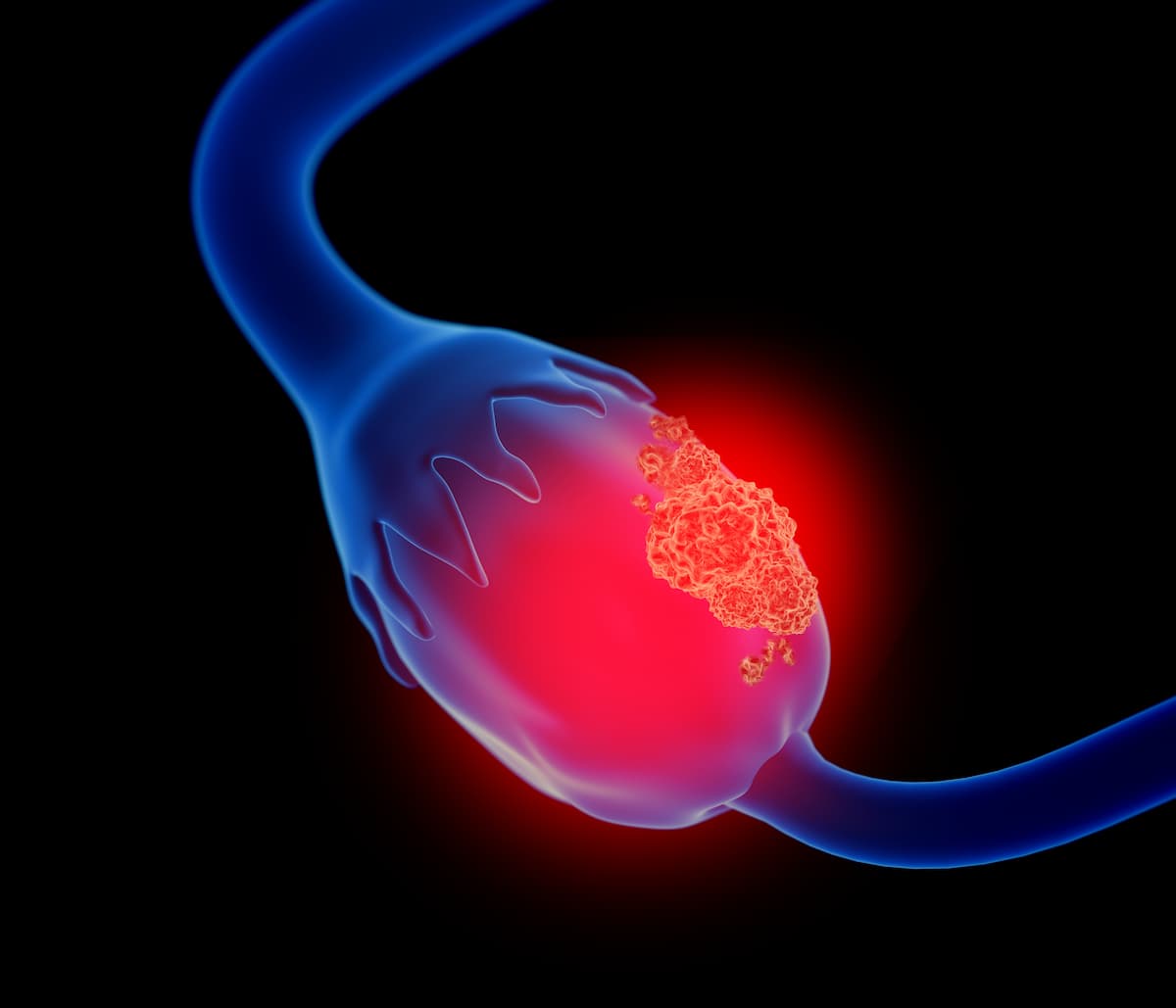Botensilimab Plus Balstilimab Yields Enduring Responses in R/R Ovarian Cancer
Patients with resistant or refractory ovarian cancer experience clinical benefits after receiving botensilimab plus balstilimab in the phase 1 C-800 study.
Treatment with botensilimab (AGEN1181) plus balstilimab (AGEN2034) produced deep responses in patients with refractory or resistant ovarian cancer, according to results from the phase 1 C-800 study (NCT03860272) presented at The Society of Gynecologic Oncology (SGO) 2023 Annual Meeting on Women’s Cancer.1
"We were very encouraged because, aside from deep responses, the responses were also very durable," according to an expert from Harvard Medical School.

Data from patients with ovarian cancer in the C-800-01 cohort of the multi-arm study (n = 24) showed that the doublet elicited an overall response rate (ORR) of 33% (95% CI, 15.6%-55.3%), which included 1 (4%) complete response and 7 (29%) partial responses. Eight patients achieved stable disease and 8 patients experienced disease progression.
Lead author Bruno Bockorny, MD, added that the response was durable. At a median follow-up of 6.9 months (range, 1.7-29.2), the median duration of response was not yet reached (4.2-not reached). The disease control rate was 67% (95% CI, 44.7%-84.4%).
“We were very encouraged because, aside from deep responses, the responses were also very durable,” Bockorny, who is also an assistant professor of medicine with Harvard Medical School and an attending physician in Gastrointestinal Oncology at Beth Israel Deaconess Medical Center, said in an interview with OncLive®. “We had multiple patients [experience] very prolonged clinical benefits, either disease stabilization or responses.”
He added that with this small patient population, investigators could not identify a biomarker separating responders from nonresponders. Enrollment to the trial is ongoing. “We are looking at, for instance, PD-1 as a potential marker; [however,] in this limited analysis of 24 patients, we are seeing that both patients with PD-1 [expression] are responding, but also [those without] PD-1 expression are also responding.”
These patients are part of a much larger evaluation of botensilimab, which is an Fc-engineered recombinant human immunoglobulin G1 monoclonal anti–CTLA-4 antibody, with or without the anti–PD-1 monoclonal antibody balstilimab in a variety of solid cancers. Bockorny noted that there are few options for patients with resistant/refractory ovarian cancer. However, response rates achieved with single-agent chemotherapies or other investigational immunotherapy combinations are usually less than 10%, he added.
“The novelty here, with botensilimab, as compared with the first-generation anti–CTLA-4 agents…is that it is a multifunctional CTLA-4 agent. In addition to binding the CTLA-4, botensilimab also had some point mutations in the Fc region; that’s the back end of the molecule that increases the binding to some receptors in the antigen-presenting cells and natural killer cells,” Bockorny explained. “These receptors are called activating Fc gamma receptors, but by engaging other immune cells, the drug can cause a [tighter] immune synapse and trigger better immune responses that we don’t have with other first-generation CTLA-4 agents.”
Patients with platinum-resistant or refractory, metastatic disease received 1 mg/kg (29%) or 2 (71%) mg/kg of botensilimab every 6 weeks plus 3 mg/kg of balstilimab every 2 weeks. Patients were allowed to have received prior immunotherapy, and crossover from prior botensilimab monotherapy was allowed.
The median patient age was 64 years (range, 37-75). Fourteen patients (58%) had an ECOG performance status of 0 and the remaining 10 (42%) had a status of 1. Bockorny noted that this was a very heavily pretreated cohort. The median number of prior therapies received was 4 (range, 1-8). Nineteen patients (79%) received prior bevacizumab (Avastin) and 5 (21%) received prior immunotherapy.
Regarding histology, 19 patients (79%) had high-grade serous disease, 1 (4%) had carcinosarcoma, and 2 (8%) each had mixed (clear cell/endometrioid) or clear cell disease. Two of 13 patients (15%) were BRCA1/2positive and 44% (n = 7/16) were PD-L1 positive.
Bockorny said the combination showcased a manageable toxicity profile. The rate of grade 3/4 treatment-related adverse effects (TRAEs) was 41%, most of which was attributable to grade 3 immune-mediated diarrhea/colitis (21%).
Other TRAEs reported with the combination included nausea (all-grade, 33%; grade 3, 4%), vomiting (all-grade, 17%), fatigue (all-grade, 38%; grade 3, 4%), pyrexia (all-grade, 25%), rash (all-grade, 33%; grade 3, 4%), pruritus (all-grade, 33%), and arthralgia (all-grade, 21%).
“What’s particularly important for this safety profile is we did not have any treatment-related deaths,” Bockorny said. “Importantly, we do not have any pneumonitis, hypophysitis, or myocarditis of any grade. It’s very consistent with the larger data sets of botensilimab and balstilimab, [where] we see very little high-grade visceral toxicity outside of the [gastrointestinal] tract. That was an important safety point, and we were pleased to see that.”
Findings presented at the 2023 Gastrointestinal Cancers Symposium showed that botensilimab and balstilimab elicited deep objective responses with evidence of durability and encouraging tolerability in heavily pretreated patients with refractory microsatellite stable metastatic colorectal cancer.2
At a median follow-up of 7 months (range, 2-31), the doublet elicited an ORR of 23% (95% CI, 14%-34%) among 70 evaluable patients; 69% of responses were ongoing at data cutoff. The median progression-free survival was 4.1 months (2.8-5.5). The 12-month overall survival (OS) rate was 63% (95% CI, 46%-76%), and the median OS was not yet reached (95% CI, 10.3-not reached).3
References
- Bockorny B, Matulonis UA, O’Day SJ, et al. Botensilimab, a novel innate/adaptive immune activator, plus balstilimab (anti–PD-1) in patients with recurrent platinum refractory/resistant ovarian cancer. Presented at: 2023 SGO Annual Meeting on Women’s Cancer; March 25-28, 2023; Tampa, Florida.
- Agenus presents clinical data demonstrating durable responses of botensilimab/balstilimab combination in metastatic microsatellite stable colorectal cancer at ASCO GI. News release. Agenus. January 23, 2023. Accessed March 28, 2023. https://investor.agenusbio.com/news-releases
- Results from a phase 1a/1b study of botensilimab (BOT), a novel innate/adaptive immune activator, plus balstilimab (BAL; anti-PD-1 antibody) in metastatic heavily pretreated microsatellite stable colorectal cancer (MSS CRC). J Clin Oncol. 2023;41(suppl 4; abstr LBA8). https://10.1200/JCO.2023.41.4_suppl.LBA8